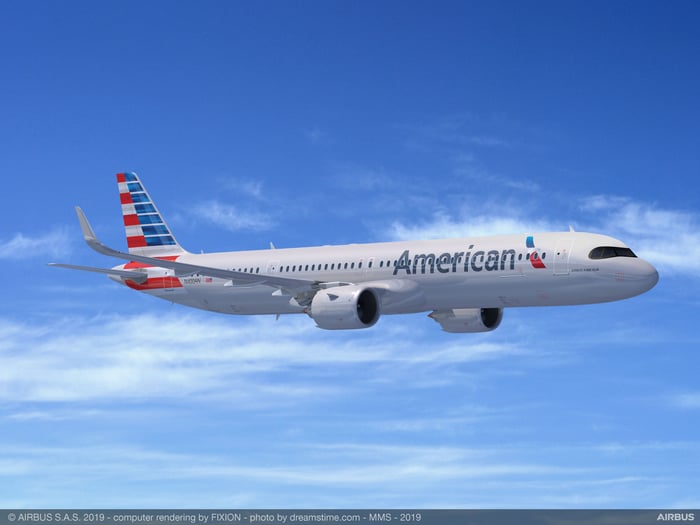As expected, Airbus (EADSY -0.22%) launched the longest-range variant of its popular A321neo jet -- the A321XLR -- at last week's Paris Air Show. With a stated range of 4,700 nautical miles, the A321XLR will have by far the most range in its size class, allowing airlines to open up new long-haul routes that don't have enough demand to support wide-body service.
The A321XLR has already attracted substantial interest from airlines. During the air show, Airbus won 48 firm orders and 79 commitments for the new model, and customers converted another 99 firm orders from other models to the A321XLR.
No. 1 global airline American Airlines (AAL 1.08%) made the biggest commitment to the new jet model, agreeing to take 50. Let's take a look at why American Airlines is so bullish on the A321XLR.
More than just a 757 replacement
Like the other two big U.S. network carriers, American Airlines currently uses Boeing 757-200s for "long-and-thin" routes between the East Coast and Europe, as well as on certain routes to South America. However, the 757 has been out of production for 15 years. The 34 Boeing 757s that American still operates are nearly 20 years old on average.
American Airlines plans to replace 10 of its remaining 757s later this year, but there is no good substitute currently available for the other 24, which serve longer routes. The A321XLR is perfect, though, offering more range and 30% lower fuel burn per seat.

American Airlines will add 50 A321XLRs to its fleet between 2023 and 2025. Image source: Airbus.
As a result, American has decided to convert 30 of its existing Airbus A321neo orders to the A321XLR variant. The first eight will arrive in 2023 -- the first year of availability -- with the remaining 22 coming in 2024. That will be perfect timing for replacing American Airlines' last 24 757s.
However, American Airlines' management sees the Airbus A321XLR as more than just a replacement for the carrier's current 757s. The airline exercised 20 of its A321neo options to order additional A321XLRs that will arrive in 2025, bringing its A321XLR fleet to a total of 50 aircraft.
Enabling new routes
Given that American Airlines plans to take roughly twice as many A321XLRs as it would need to replace the 24 757s that will remain in its fleet after this year, the airline clearly expects this aircraft to open up new growth opportunities.
The A321XLR could be particularly useful in Philadelphia, American's main transatlantic hub. Philadelphia doesn't have the same level of local demand as New York, where Delta Air Lines and United Continental have their main transatlantic gateways. Thus, having a smaller long-haul aircraft could be vital for sustaining service to destinations that attract less traffic.

Image source: American Airlines.
American will also be able to fly from its Miami hub to pretty much anywhere in South America using the A321XLR. This could help the carrier expand its service to Brazil, where it has had to eliminate several routes in recent years due to a downturn in demand. Demand for travel to South America tends to be counterseasonal compared to the transatlantic market, so American may be able to serve smaller international destinations on a seasonal basis, flying A321XLRs to Europe during the spring and summer and to South America during the fall and winter.
The international expansion opportunities provided by the Airbus A321XLR will help American Airlines diversify away from the domestic market, to which it has greater exposure than its main rivals.
One small piece of the profitability-improvement puzzle
As a small, fuel-efficient aircraft capable of flying long-haul routes, the A321XLR will improve American Airlines' ability to match capacity to demand in its international network. And by enabling the carrier to add more international routes to its arsenal, the new aircraft will put American Airlines in a better position to win valuable corporate travel contracts.
American's A321XLRs will also enable the airline to simplify its fleet, as the plane will be very similar to the A321s and A321neos that American Airlines already operates. Meanwhile, the older 757 family will be fully retired by 2025 at the latest, reducing the company's costs.
The Airbus A321XLR certainly isn't a complete solution to American Airlines' recent struggles with weak profitability. Nevertheless, it could become an important part of the airline's turnaround plan.





